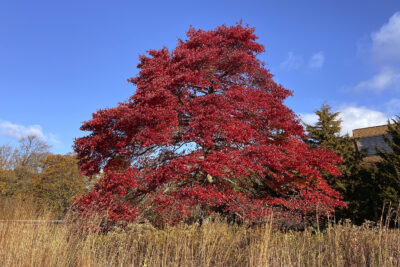
Lilacs blooming in Longenecker Horticultural Gardens.
The Longenecker Horticultural Gardens are the UW–Madison Arboretum’s arboretum, containing the largest and most diverse collection of woody plants in the state. On April 19, 1935, the first specimens were planted: fifty-four different types of lilacs, many of which are still in the collection today.
These first plants were transplanted and maintained by Civilian Conservation Corps (CCC) members stationed at the UW Arboretum from 1935 to 1941. The CCC crew also hand dug the beds where the lilacs were planted.
The bed configuration and planting scheme were created by G. William “Bill” Longenecker, a professor of horticulture and landscape architecture at UW–Madison, who designed the beds to create small intimate “rooms.” He was also the Gardens’ first curator and served as the Arboretum’s first director.
Known simply as the “horticultural area” at the time, it would be named for Longenecker in 1967 to honor his contributions.

Bill’s initial idea for the lilac collection, as stated in a CCC Arboretum Newsletter from May 16, 1941, was for it to “be one of the greatest collections in the country.” Ninety years later, the lilac collection is recognized as the third largest public collection in the United States, according to the International Lilac Society. While historic, the collection is also contemporary, evolving as new lilacs have been added almost every year since 1935. Seven new plants are scheduled to be added in 2025.
Longenecker Horticultural Gardens has also evolved. More than a collection of lilacs, it has grown to house over 2,600 different plant taxa spread across 40 acres and includes nationally acclaimed collections of crabapples, magnolias, and conifers. A large portion of the Gardens’ specimens were procured and added by Ed Hasselkus, a professor of horticulture at UW–Madison and a former undergraduate student of Bill’s.
Ed would become the second LHG curator in 1966, and he led the Gardens’ development for forty-eight years. He also formalized the record-keeping of the Longenecker collection with an accessioning system to ensure that every plant would be recorded, of known origin, labeled, and tracked.

In 2015, I was privileged to become the collection’s third curator, though my connection to the Gardens began in 1991 when I came to UW–Madison as one of Ed’s graduate students. Over the last ten years I have continued developing the Gardens, adding over 600 new specimens while also honoring its history.
In 2024, after years of development, I was delighted to oversee implementation of a new digital database for the LHG plant records that would also make the collection’s holdings publicly available online for the first time through an IrisBG collections web explorer for the Longenecker Horticultural Gardens, helping to preserve the Gardens’ legacy into the future.

Entering their tenth decade, the Longenecker collections also contain two Wisconsin state champion trees. The most visible is the “Carolyn” black tupelo (Nyssa sylvatica) tree planted in front of the Visitor Center. It was purchased by Bill Longenecker in 1956 as a seedling for 40 cents from a nursery in Exeter, New Hampshire, owned by Isaac Langley Williams. The seedling grew in the Arboretum’s nursery and was transplanted to where it now stands on October 3, 1961.
The tree’s tiered branch habit is typical of the species. Its glorious fall color is unique, however: it consistently displays a vivid dark maroon color and not the yellows, oranges, and light reds more common in the species. The leaves also persist later into autumn than most black tupelo. Because of these unique attributes it was later given the cultivar name “Carolyn” to honor Ed Hasselkus’s first granddaughter. The name also indicates that the tree is female.

The other champion tree is a blue ash (Fraxinus quadrangulata), located in the LHG ash collection. It was grown from seed collected from a naturally occurring tree in a wooded area of the Morton Arboretum in Lisle, Illinois. It was distributed to the UW Arboretum by the USDA Regional Plant Introduction Station in Ames, Iowa, in 1960. The blue ash also grew to size in the Arboretum’s nursery and was planted in its current site on November 4, 1968. It is one of three ash trees at the Arboretum being treated for emerald ash borer to help ensure its survival. Both tree species are extremely rare in Wisconsin, each being native to just one county: Waukesha County for blue ash, and Kenosha County for black tupelo.
As spring unfolds and Longenecker Gardens come alive, attracting thousands of visitors with their dazzling array of floral beauty, let’s take a moment to remember all the years of work and foresight that went into creating this unique Madison treasure.
– David Stevens, Ed Hasselkus curator, Longenecker Horticultural Gardens

